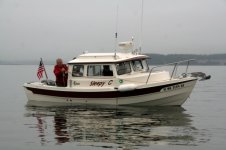I'm not sure if this has been covered but if a C-Dory capsizes is it self-righting ?
If it's not and you're in the cabin, or the vee-berth, you'll need to swim down and away to escape.
Would this suggest that a manual inflating PFD is desirable ?
From Coast Guard Auxiliary.
http://sites.google.com/site/uscgauxops ... d-survival
"Most boats are not surfboats and will not recover from a rollover.
All exits are upside down after capsizing.
Egress Routes:
Hatches large enough to get through
Cabin windows
Cabin doors
There usually will be some air pockets in the uppermost (upside down) sections of the boat.
Remove PFDs to exit the boat.
Tie a line to PFDs to pull them out after exiting.
Best swimmer exits first, carrying a line for the others to follow."
Here is a passage from a Transportation Safety Board of Canada (TSB) investigation...
http://www.tsb.gc.ca/eng/rapports-repor ... 8m0062.asp
Emergency Egress
At the time of the occurrence, three of the crew members were on the stern, four were in the pilot house, and one stood in the open port door. When the vessel capsized, the three crew members on the stern swam clear of the vessel. Shortly thereafter, the crew member who had been standing in the doorway surfaced.
Those inside the pilot house quickly became disoriented as the buoyancy in their PFDs pinned them to the deck overhead. Attempts to open the closed starboard door were not successful, and one person discarded his PFD in order to escape. The remaining three eventually surfaced after exiting through the port door.
And this from the sinking of the Taki-Tooo off Tillamook Bar
http://community.seattletimes.nwsource. ... ug=boat21m
Investigators say one of the victims of the Taki-Tooo fishing boat disaster off the Oregon coast was wearing a life jacket but apparently died after being trapped in the boat's overturned cabin.
Here is a related discussion at Sailnet
Inflatable PFDs -- Manual or Automatic?
It seems that a person must weigh whether he's more likely to be struck in the head insensibly or stuck inside a capsized cabin.
Auto or manual each jacket should have a whistle and a strobe.

